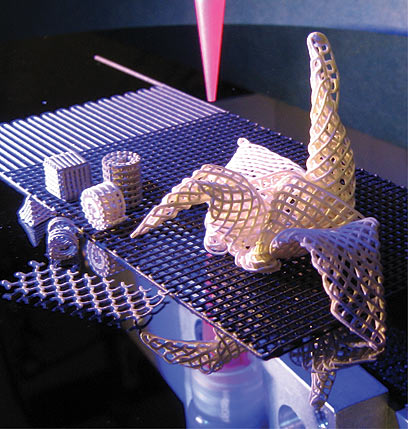Modern technology of printing layers of liquid metal and folding them like in origami, makes it possible to create complex three-dimensional shapes like a crane made of titanium. The folding method will be used in the future to create complex devices for medical transplantation that will support, for example, tissue construction

Keren Maron, "Galileo"
Already in the 17th century, the Japanese knew how to fold pieces of paper into magnificent sculptures. Today, origami, the Japanese art of paper folding, is integrated into the most advanced technologies of the 21st century. An example of such technology is XNUMXD printing, which allows the user to design an object on a computer and produce it at the push of a button, without the need for assembly.
The laboratory of Dr. Jennifer Lewis (Lewis) at the University of Illinois in the United States deals a lot with XNUMXD printing and especially with the development of methods for printing complex objects from durable materials such as metal, plastic and ceramics.
Lewis is one of the founders of a technology called direct-write assembly, in which a printer prints layers of liquid ink containing particles of the desired material.
A metal crane and other folds created by the special method of XNUMXD printing (Photo: Bok Yeop Ahn)
The liquid in it evaporates after printing and leaves behind the material (metal, for example), and the dry layer is printed with another layer of ink. The final object obtained is exposed to different temperatures to stabilize it (in a process called annealing). However, this printing technology has limitations.
For structures consisting of many layers, the lower layers are sometimes unable to bear the burden of the upper layers and lose their shape. Dr. Bok Yeop Ahn, a researcher in Lewis' laboratory, proposed a sophisticated way to overcome this problem - instead of loading layers upon layers, one can print one layer and produce the desired XNUMXD structure by folding - like in origami .
wet folding
When the researchers tried to fold a printed metal "page", they ran into a problem - the liquids in it quickly evaporated, and the remaining page was not flexible enough and cracked or broke when they tried to fold it. To deal with this problem, the scientists once again turned to an ancient Japanese method, a paper folding method called "wet folding", in which the paper is moistened to make it easier to fold and shape curves. To mimic the texture of wet paper, the researchers combined quick-drying liquid inks with slowly evaporating solvents, thereby increasing their ability to control the material.
Titanium crane
The combination of folding with printing opens new assembly possibilities, which are not obtained from normal XNUMXD printing. For example, the researchers used the folding method to create a titanium crane, in such a way that the crane's wings hang above its body without support from below - a structure that cannot be produced with existing printing technologies.
According to the researchers, the folding technology could be used, among other things, to produce complex devices for medical transplantation, for example "scaffolds", structures used to support biological processes such as tissue building.
For the sake of demonstration, the researchers folded complex shapes (such as the crane) manually, but there are robots capable of performing complex folding, and it is possible that the technology of Lewis and her colleagues will encourage progress in this field as well.
The article was published in "Galileo" magazine from Moto Communications.

3 תגובות
I checked in the search engine. But in the end I found it, it turns out that Moshe Nachmani wrote about the subject.
https://www.hayadan.org.il/printed-origami-offers-new-technique-for-small-complex-structures-2504101/
Happens
To the best of my memory, the current article has already been published here before. Why recycle?
And how do you fold Ahmadingad?